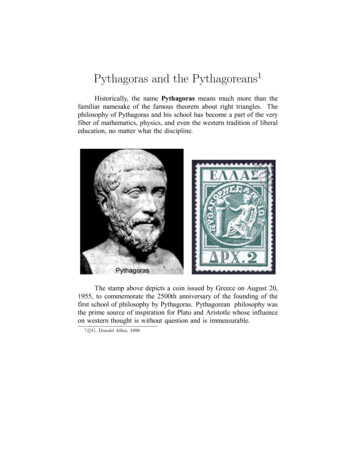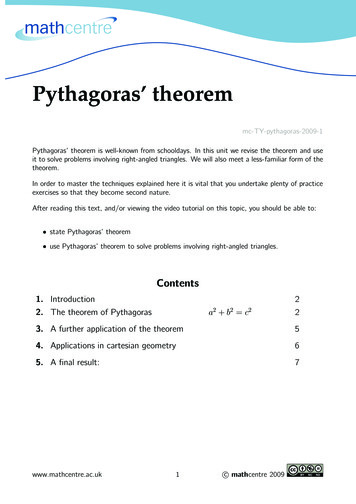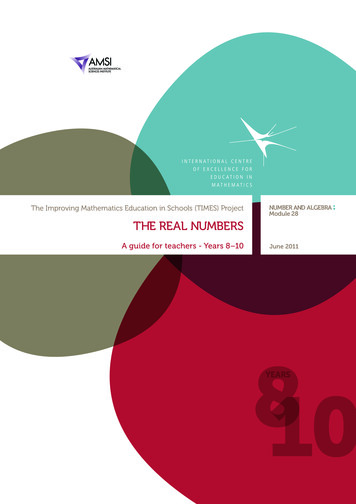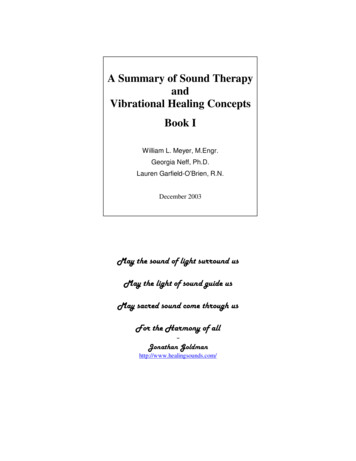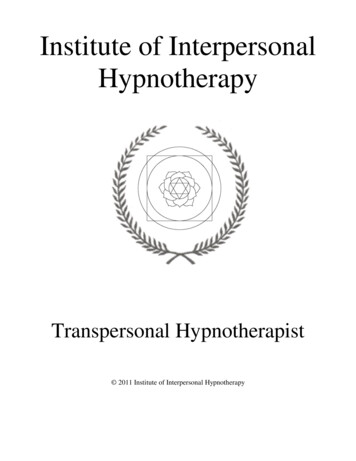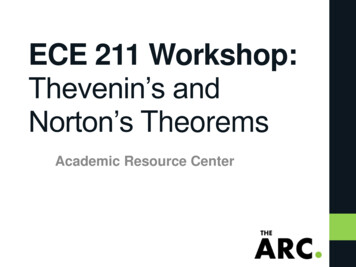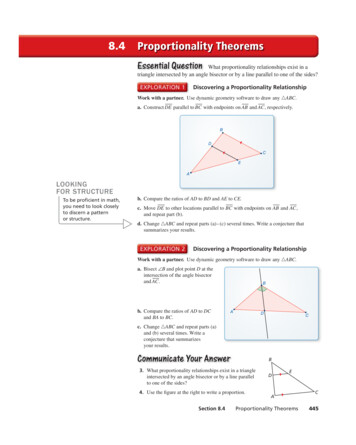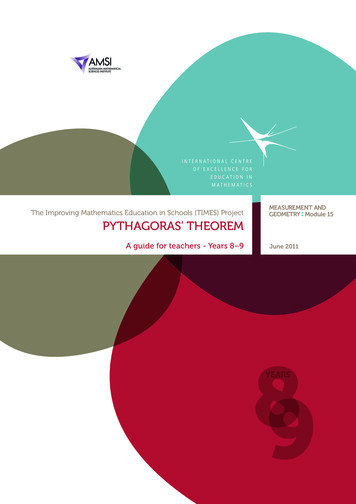
Transcription
The Improving Mathematics Education in Schools (TIMES) Project EASUREMENT ANDMGEOMETRY Module 15PYTHAGORAS’ THEOREMA guide for teachers - Years 8–9June 201189YEARS
Pythgoras’ theorem(Measurement and Geometry: Module 15)For teachers of Primary and Secondary Mathematics510Cover design, Layout design and Typesetting by Claire HoThe Improving Mathematics Education in Schools (TIMES)Project 2009‑2011 was funded by the Australian GovernmentDepartment of Education, Employment and WorkplaceRelations.The views expressed here are those of the author and do notnecessarily represent the views of the Australian GovernmentDepartment of Education, Employment and WorkplaceRelations. The University of Melbourne on behalf of the internationalCentre of Excellence for Education in Mathematics (ICE‑EM),the education division of the Australian MathematicalSciences Institute (AMSI), 2010 (except where otherwiseindicated). This work is licensed under the CreativeCommons Attribution-NonCommercial-NoDerivs 3.0Unported nd/3.0/
MEASUREMENT ANDGEOMETRY Module 15The Improving Mathematics Education in Schools (TIMES) ProjectPYTHAGORAS’ THEOREMA guide for teachers - Years 8–9June 2011Peter BrownMichael EvansDavid HuntJanine McIntosh89Bill PenderJacqui RamaggeYEARS
{4}The Improving Mathematics Education in Schools (TIMES) ProjectPYTHAGORAS’THEOREMASSUMED KNOWLEDGE Familiarity with measurement of lengths, angles and area. Basic knowledge of congruence and similarity. Familiarity with simple geometric proofs. Simple geometric constructions. Factorisation of whole numbers. Simple surd notation.MOTIVATIONIs there a simple relationship between the length of the sides of a triangle? Apart from thefact that the sum of any two sides is greater than the third, there is, in general, no simplerelationship between the three sides of a triangle.Among the set of all triangles, there is a special class, known as right-angled triangles orright triangles that contain a right angle. The longest side in a right-angled triangle is calledthe hypotenuse. The word is connected with a Greek word meaning to stretch becausethe ancient Egyptians discovered that if you take a piece of rope, mark off 3 units, then 4units and then 5 units, this can be stretched to form a triangle that contains a right angle.This was very useful to the Egyptian builders.This raises all sorts of questions. What is so special about the lengths 3, 4 and 5? Arethere other sets of numbers with this property? Is there a simple relationship between thelengths of the sides in a right-angled triangle? Given the lengths of the sides of a triangle,can we tell whether or not the triangle is right angled?
The Improving Mathematics Education in Schools (TIMES) ProjectMost adults remember the mathematical formulac2 a2 b2or perhaps“the square on the hypotenuse is the sum of the squares on the other two sides.”The first version uses an implied standard notation, the second version uses archaiclanguage but both are Pythagoras’ theorem. This theorem enables us to answer thequestions raised in the previous paragraph.The discovery of Pythagoras’ theorem led the Greeks to prove the existence of numbersthat could not be expressed as rational numbers. For example, taking the two shortersides of a right triangle to be 1 and 1, we are led to a hypotenuse of length 2, which isnot a rational number. This caused the Greeks no end of trouble and led eventually to thediscovery of the real number system. This will be discussed briefly in this module but willbe developed further in a later module, The Real Numbers.Triples of integers such as (3, 4, 5) and (5, 12, 13) which occur as the side lengths ofright‑angled triangles are of great interest in both geometry and number theory – they arecalled Pythagorean triples. We find all of them in this module.Pythagoras’ theorem is used in determining the distance between two points in bothtwo and three dimensional space. How this is done is outlined in the Links Forwardsection of this module.Pythagoras’ theorem can be generalised to the cosine rule and used to establish Heron’sformula for the area of a triangle. Both of these are discussed in the Links Forward section.{5}
{6}The Improving Mathematics Education in Schools (TIMES) ProjectCONTENTSTANDARD NOTATIONLet ABC be a triangle. We may write ABC.BcThen by convention, a is length of the interval BC.aWe also talk about angle A or A for BAC.AbSo a is the length of the side opposite angle A.CUsing this notation we can succinctly state Pythagoras’ theorem and two of the mostimportant theorems in trigonometry, the sine rule and the cosine rule. The sine rule andcosine rule are established in the Links Forward section.RIGHT-ANGLED TRIANGLESAmong the set of all triangles there is a special classknown as right-angled triangles or right triangles. A righttriangle has one angle, a right angle. The side oppositethe right angle is called the hypotenuse. It is the longestside of the trianglehypotenuseWe also talk about the shorter sides of a right-angled triangle.ALet us use the standard notation describedabove and assume C 90 .If a and b are fixed then c is determined.Also a c, b c and c a b.bCTo prove c is determined note that ACB DFE (SAS), so c y(See the module, Congruence)ABaDbCcbcaBFyaE
The Improving Mathematics Education in Schools (TIMES) Project{7}THE THEOREMA triangle with sides 3 cm, 4 cm, 5 cm is a right-angled triangle. Similarly, if we draw aright‑angled triangle with shorter sides 5 cm, 12 cm and measure the third side, we findthat the hypotenuse has length ‘close to’ 13 cm. To understand the key idea behindPythagoras’ theorem, we need to look at the squares of these numbers.You can see that in a 3, 4, 5 triangle, 9 16 25 or 32 42 52 and in the 5, 12, 13triangle,25 144 169 or 52 122 132.We state Pythagoras’ theorem: The square of the hypotenuse of a right-angledAtriangle is equal to the sum of the squaresof the lengths of the other two sides.cb In symbols c2 a2 b2.BaEXAMPLEFind the length of the hypotenusein the right triangle opposite.x1216SOLUTIONLet x be the length of the hypotenuse. Then by Pythagoras’ theorem,x2 122 162 400. So x 20.Proof of the theoremA mathematical theorem is a logical statement, ‘If p then q’ where p and q are clausesinvolving mathematical ideas. The converse of ‘If p then q’ is the statement, ‘If q then p’.The converse may or may not be true but certainty needs a separate proof.Converse of Pythagoras’ theorem: If c2 a2 b2 then C is a right angle.There are many proofs of Pythagoras’ theorem.Proof 1 of Pythagoras’ theoremFor ease of presentation let 1 ab be the area of the right‑angled triangle ABC with2right angle at C.C
{8}The Improving Mathematics Education in Schools (TIMES) ProjectThe two diagrams show a squareof side length a b divided up intovarious squares and triangles congruentto ABC.baa2aaaaccc2b(1)bcbbcaaabFrom the right hand diagram(a b)2 4 c2(2)Comparing the two equations we obtain c2 a2 b2 and the theorem is proved.Several other proofs of Pythagoras’ theorem are given in the Appendix.EXERCISE 1Find the hypotenuse of the right-angled triangles whose other sides are:a 5, 12b 9, 12c 35, 12d 15, 8e 15, 20f15, 112Note: Clearly one can use a calculator and reduce each of the above calculations to halfa dozen keystrokes. This leads to no insights at all. As a suggestion, if a perfect square isbetween 4900 and 6400 then the number is between 70 and 80. If the last digit of thesquare is 1 then the number ends in a 1 or a 9, etc.Applications of Pythagoras’ theoremEXAMPLEA rectangle has length 8 cm and diagonal 17 cm.What is its width?SOLUTION17 cm8 cmb cmLet b be the width, measured in cm. Then172 82 b2289 64 b2b2 289 – 64 225,(Pythagoras’ theorem)so b 15.The width of the rectangle is 15 cm.b2bFrom the left hand diagram(a b)2 a2 b2 4 b
The Improving Mathematics Education in Schools (TIMES) Project{9}EXERCISE 2A ladder of length 410 cm is leaning against a wall.It touches the wall 400 cm above the ground.What is the distance between the foot of theladder and the wall?410 cm400 cmThe Converse theoremWe now come to the question:Given the lengths of the sides of a triangle, can we tell whether or not thetriangle is right angled?This is answered using the converse of Pythagoras’ theorem.The converse theorem says:If a2 b2 c2 then the triangle is right angled (with right angle at C).Thus, for example, a triangle with sides 20, 21, 29 is right angled since202 212 400 441 841 292The obvious question, which we shall answer later in this module, is can we find all such‘Pythagorean triples of whole numbers’?We shall give two proofs of the converse – rather different in nature. However, both usethe theorem itself in the proof! This does not often happen in elementary mathematicsbut is quite common in more advanced topics.First proof of the converseWe assume c2 a2 b2Construct a second triangle DEFwith EFD 90 , EF a and DF b.BThen, by Pythagoras’ theorem,ED2 a2 b2.aBut c2 a2 b2 so ED c. HenceCEcbaA ABC DEF (SSS).So, BCA 90 since EFD 90 and the converse is proved.FbD
{10}The Improving Mathematics Education in Schools (TIMES) ProjectBSecond proof of the converseWe assume c2 a2 b2Drop the perpendicular from B to AC,assume D is between A and C.xyClearly x a and y b soc2 x2 y2caCDb(Pythagoras’ theorem) a2 b2 c2This is a contradiction, so C D or D is to the left of C on the line AC.EXERCISE 3Work out the details of the proof when D is to the left of C on the line AC.EXAMPLEWhich of the triangles below are right-angled triangles?Name the right angle in each case.aA14 cmbDB36 cm32 cm39 cm27 cmF15 cmECSOLUTIONa Triangle ABC is not a right-angled triangle since 142 272 322.b Triangle DEF is a right-angled triangle since 152 362 392. F is the right angleIRRATIONAL NUMBERSConsider the sequence 1 , 2, 3, 4, 5, 201352This sequence of positive real numbers is strictly increasing and n is a whole number ifand only if n is a perfect square such as 36 or 49. The sequence tends to infinity, that is,there is no upper bound for n.A
The Improving Mathematics Education in Schools (TIMES) ProjectA right-angled triangle with equal side lengths is an isosceles triangle. Hence the anglesare 45 , 45 and 90 . If the length of a side is 1 then the hypotenuse is of length 2 (since12 12 2).Next we consider the right-angled triangle with shorter sides 1 and 2 . It’s hypotenusehas length 3 . We can iterate this idea obtaining:211321453141Using the above constructions it follows that a length where n is a whole number greaterthan 1, can be constructed using just ruler and compass (see module, Constructions).Since 1 2 2, 2 is not a whole number but perhaps 2 is rational. This is not so, aswas discovered about 600BC. These ideas are dealt with in more detail in the module,The Real Numbers.When irrational numbers occur in problems involving Pythagoras’ theorem, we can either leave the answer in symbolic form, for example 24 ( 2 6) or approximate the answer using a calculator, for example 2 6 4.90(to two decimal places).EXAMPLEFind the length, correct to 2 decimal places,of the missing side in the right triangle opposite.SOLUTIONBy Pythagoras’ theorem,x2 52 72x2 25 49x2 24x 24 2 6 4.90 (correct to two decimal places)5x7{11}
{12}The Improving Mathematics Education in Schools (TIMES) ProjectEXERCISE 4A cross-country runner runs 3km west, then 2km south and then 8km east. How far is shefrom her starting point? Give your answer in kilometres and correct to 2 decimal places.EXERCISE 5Find the exact length of the long diagonal in a cube of side length 3 cm.PYTHAGOREAN TRIADSThree whole numbers that are the lengths of the sides of a right-angled triangle are calleda Pythagorean Triad or Pythagorean Triple. Thus, {3, 4, 5} is a Pythagorean Triad.The formula for how to generate such triples was known by about 2000BC. This is“proved” by a clay tablet (Plimpton 322) which contains fifteen different triples including(1679, 2400, 2929). The tablet is dated to 1800 BC. With your calculator check this is aPythagorean triple. This was obviously not found by chance!Starting with (3, 4, 5) we can find or construct infinitely many such triples by taking integermultiples:(3, 4, 5), (6, 8, 10), (9, 12, 15), .Consider a triple (a, b, c) of positive whole numbers with a2 b2 c2. If a and b have acommon factor then it also divides c. So a useful definition is that the Pythagorean triple(a, b, c) is primitive if, HCF (a, b) HCF (b, c) HCF (a, c) 1 that is, the highest commonfactor of a and b is 1, etc. If we can find all primitive Pythagorean triples then we can findall triples by simply taking whole number multiples of the primitive triples.There are various families of examples. Consider the identity:(n 1)2 – n2 2n 1So if 2n 1 is a perfect square then we can construct a primitive triple ( 2n 1 , n, n 1).In this way, taking 2n 1 9, 25, 49, 81, . we obtain triples:(3, 4, 5); (5, 12, 13); (7, 24, 25); (9, 40, 41), .It is possible to list all primitive triples. One form of this ‘classification’ is in the followingtheorem. We shall prove it using some elementary number theory including the use ofthe fundamental theorem of arithmetic and the use of the HCF. The symbol is used for‘divides exactly into’. The result gives a formula for all primitive Pythagorean Triads.
The Improving Mathematics Education in Schools (TIMES) ProjectTheoremIf a2 b2 c2 and (a, b, c) is a primitive triad then a p2 – q2, b 2pq andc p2 q2 where the HCF of p and q is 1 and p and q are not both odd.ProofAt least one of a, b and c is odd since the triad is primitive.The square of a whole number is either a multiple of 4 or one more than a multipleof 4, hence a and b cannot both be odd.So we may assume a is odd, b is even and c is odd.c2 a2 b2 so b2 c2 – a2 (c – a)(c a)Let d be the HCF of c – a and c a, so d c –a and d c a so d 2c and d 2aBut a and c are coprime so d 1 or 2 but c – a and c a are even. So d 2Hence we havec–a2andc a2b2c–a c a4 2 . 2Setc a2 p2 ,are coprime integers. Butsoc–a2c–a2is a square as isc a2 . q2 then c p2 q2 , a p2 – q2 andb24 p2q2 or b 2pq.Finally if p and q are odd then a and c are even which is not the case.So the theorem is proved.EXAMPLE22 – 12 3, 2 2 1 4 and 22 12 5 so the triple (3, 4, 5) corresponds to (p, q) (2, 1)EXERCISE 6Investigate:a (p, q) (2, 1), (3, 2), (4, 3), .b (p, q) (4, 1), (5, 2), (6, 3), (7, 4), .c (p, q) (2, 1), (4, 1), (6, 1), (8, 1), .{13}
{14}The Improving Mathematics Education in Schools (TIMES) ProjectEXERCISE 7Find the values of p and q corresponding to the triple (1679, 2400, 2929) from the claytablet Plimpton 322. The largest triple on Plimpton 322 is (12 709, 13 500, 18 541) – find pand q in this case as well.LINKS FORWARDTHE DISTANCE FORMULA IN R2 (THE COORDINATE PLANE)yIn two dimensional coordinate geometry perhapsthe most basic question is ‘What is the distance betweentwo points A and B with coordinates (x1, y1) and (x2, y2)?’B(x2, y2)Suppose that A(x1, y1) and B(x2, y2) are two pointsin the plane.X(x2, y1)A(x1, y1)Consider the right-angled triangle AXB whereX is the point (x2, y1). ThenxAX x2 – x1 or x1 – x2 andBX y2 – y1 or y1 – y2depending on the relative positions of A and B.By Pythagoras’ theoremAB2 AX2 BX2 (x2 – x1)2 (y2 – y1)2Therefore AB BA (x2 – x1)2 (y2 – y1)2DISTANCES IN THREE-DIMENSIONAL SPACEThe distance d from (0, 0) to (x, y) in the coordinate plane satisfies d2 x2 y2.We can extend coordinate geometry to 3-dimensionsby choosing a point O called the origin and choosingthree lines through O all perpendicular to each other.We call these lines the x-axis, the y-axis and the z-axis.zPyIt is possible to go from O to any point P by ‘moving’a units along the x-axis, then b units parallel to they-axis and then c units parallel to the z-axis.We say the coordinates of the point P are (a, b, c).cBbOaAx
The Improving Mathematics Education in Schools (TIMES) Project{15}Again a basic question is ‘What is the distance OP?’ The answer isOP2 a2 b2 c2.To see this, let A (a, 0, 0) and B (a, b, 0). The triangle OAB is right-angled at A.Hence OB2 OA2 AB2 a2 b2.Next OBP is right–angled at B so OP2 OB2 BP2 a2 b2 c2.CIRCLES IN THE PLANE, CENTRE THE ORIGINA circle is the path traced out by a point moving a fixed distance from a fixed pointcalled the centre.First suppose we draw a circle in the Cartesian plane centre the origin and radius 1and suppose (x, y) is on this circle.yr1(x, y)(x, y)r1xr1Then by Pythagoras’ theorem (or the distance formula in R2)x2 y2 12Conversely, if x2 y2 1 then the point (x, y) lies on the circle of radius 1.Similarly, if x2 y2 r2 then (x, y) lies on the circle, centre the origin, of radius r andconversely all points on this circle satisfy the equation.PYTHAGORAS’ THEOREM IN TRIGONOMETRYAConsider the right-angled triangle ABC, with C 90 and B Now by definition cos acband sin c .By Pythagoras’ theorem, a2 b2 c2. Thereforeac2 bc2c 1.bHence, one of the most fundamental identities in trigonometry.cos2 sin2 1There are 2 important formulas linking the side lengthsof a triangle and the angles of the triangle.BaC
{16}The Improving Mathematics Education in Schools (TIMES) ProjectCTheorem – The cosine ruleLet ABC be a triangle with an acute angle at A.b22a2Then a b c – 2bc cos AAABcProofSuppose the altitude from C has length h anddivides AB into intervals of length x and yCb2 h2 x2 andhxAa2 h2 y2Also c x yabBy Pythagoras’ theoremso, eliminating h2a2 – b2 y2 – x2a2 b2 c2 – (x y)2 y2 – x2 b2 c2 – 2x2 – 2xy b2 c2 – 2x(x y)Nowx b cos A and x y c soa2 b2 c2 – 2bc cos AEXERCISE 8Show that the cosine rule is still true when A is obtuse.asin ATheorem – The sine rule bsin B csin CEXERCISE 9Write down expressions for sin A and sin B and hence prove the sine rule.CabhAByB
The Improving Mathematics Education in Schools (TIMES) ProjectAPOLLONIUS’ THEOREM AND HERON’S FORMULAEuclid’s Elements was written about 300BC. As discussed elsewhere in these modulesthis amazing set of thirteen books collected together most of the geometry and numbertheory known at that time. During the next century Apollonius and Archimedes developedmathematics considerably. Apollonius is best remembered for his study of ellipses, parabolasand hyperbolas. Archimedes is often ranked as one of the most important mathematiciansof all time. He carried out a number of calculations, which anticipated ideas from integralcalculus. In this section we discuss Heron’s formula that scholars believe was discovered byPythagoras.We shall prove Apollonius’ theorem and Heron’s formula which both follow fromPythagoras’ theorem using algebra.Apollonius’ theoremSuppose ABC is any triangle, a 2x and m is the length of the median from A to BC thenb2 c2 2x2 2m2ProofLet length of the altitude AE be h. Also let CE t, ED s.AcbChtEmsDxBClearly s t x and there are three right-angled triangles som2 h2 s2c2 h2 (s x)2b2 h2 t2Taking into account the formula to be proved we considerc2 b2 – 2m2 h2 (s x)2 h2 t2 – 2h2 –2s2 s2 2sx x2 t2 – 2s2 x2 2sx t2 – s2 x2 2sx (t s)(t – s) x2 2sx (t – s)x x2 sx tx 2x2That is, b2 c2 2m2 2x2In the above diagram we asumed then C is acute and E is between C and B. The othercases can be dealt with similarly.{17}
{18}The Improving Mathematics Education in Schools (TIMES) ProjectEXERCISE 10Use the cosine rule to write m2 in ACD and c2 in ACB.Deduce Apollonius’ theorem in a couple of steps.Heron’s formulaThis is an amazing formula expressing the area of a triangle in terms of its side lengths.To write this in its standard form consider a ABC with side lengths a, b and c.We let 2s a b c and let be the area of ABC (s is the semi-perimeterof the triangle). Then 2 s (s – a) (s – b) (s – c)We give a proof that uses only Pythagoras’ theorem, the formula for the area of a triangleand some algebra.ProofLet h be the length of the altitude from C to AB whichdivides AB into intervals of length x and y.CThen x y c.bahThe area of a triangle is half base times height so 21 hc and 4 2 h2c2(1)BxPythagoras’ theorem givesa2 h2 x2(2)b2 h2 y2 h2 (c – x)2(3)We must eliminate h and x from equations (1), (2) and (3). This is non-trivial!(2) – (3)a2 – b2 h2 x2 – h2 – (c – x)2a2 – b2 2cx – c22cx a2 c2 – b2(4)Next (2) givesh2 a2 – x2substitute into (1)4 2 c2(a2 – x2)16 2 4c2a2 – 4c2x2 (5)yA
The Improving Mathematics Education in Schools (TIMES) ProjectSquare (4) and substitute into (5)16 2 (2ca)2 – (a2 c2 – b2)2This is the difference of two squares, so16 2 (2ca a2 c2 – b2)(2ca – a2 – c2 b2) ((a c)2 – b2)(b2 – (a – c)2) (a c b)(a c – b)(b a – c)(b – a c) 2s(2s – 2b)(2s – 2c)(2s – 2a)So 2 s(s – a)(s – b)(s – c)EXERCISE 11Find the areas of the triangles with side lengths:a 13, 14, 15b 13, 20, 21c 10, 17, 21d 51, 52, 53HISTORYAs outlined above, the theorem, named after the sixth century BC Greek philosopherand mathematician Pythagoras, is arguably the most important elementary theorem inmathematics, since its consequences and generalisations have wide ranging applications.It is often difficult to determine via historical sources how long certain facts have beenknown. However, in the case of Pythagoras’ theorem there is a Babylonian tablet, knownas Plimpton 322, that dates from about 1700BC. This tablet lists fifteen Pythagorean triplesincluding (3, 4, 5), (28, 45, 53) and (65, 72, 97). It does not include (5, 12, 13) or (8, 15, 17)but it does include (12 709, 13 500, 18 541)! The fifteen triples correspond (very roughly)to angles between 30 and 45 in the right-angled triangle. The Babylonian numbersystem is base 60 and all of the even sides are of the form 2a 3b 5c presumably to facilitatecalculations in base 60. Most historical documents are found as fragments and one couldcall this the Rosetta Stone of mathematics. Whichever interpretation of the purpose ofPlimpton 322 is correct, and there are several, it is clear that both Pythagoras’ theoremand how to construct Pythagorean Triples was known well before 1700BC.The nature of mathematics began to change about 600 BC. This was closely linked tothe rise of the Greek city states. There was constant trade and hence ideas spread freelyfrom the earlier civilisations of Egypt and Babylonia. Most of the history is lost forever, buttradition has it the Thales, Pythagoras and their students, were responsible for developingmany of the key ideas – in particular the need to prove theorems! What we do know iswhat was known at about 300BC. This is because Euclid of Alexandria wrote his thirteenvolume book the Elements. Contrary to popular belief, this book is by no means solelyabout geometry.{19}
{20}The Improving Mathematics Education in Schools (TIMES) ProjectBook 1 of the Elements is on geometry and attempts to set geometry on a sound logicalbasis by giving some twenty-three definitions and lists five postulates and five commonnotions. This axiomatic approach, although flawed and incomplete gave a logicalapproach to the study of geometry which was a central part of a classical education rightup to the twentieth century. The imperfections of Euclid were not fixed until 1900 whenDavid Hilbert gave a modern correct system of axioms. In Book 1 of Euclid a number oftheorems are proved such as the well-known result that in an isosceles triangle the baseangles are equal. The final theorem, Proposition 1-47, is Pythagoras’ theorem. The proofgiven is not the easiest known at the time, but uses only congruence and other resultsproved in Book 1. Euclid’s Elements are very sophisticated.APPENDIXOTHER PROOFS OF PYTHAGORAS’ THEOREMThere are hundreds of proofs of Pythagoras’ theorem –one attributed to Napoleon and one attributed to a 19th century US president!We shall present a few more including Euclid’s proof.Second proofWe take the second diagram from the first proof. is the area of the triangle so 21 ab.abbcc2The large square is a b by a b so22(a b) 4 cacccbaba2 2ab b2 4 21 ab c2aor c2 a2 b2.Third proofWe assume b a.cThe side length of the inner square is b – a(b – a)2 4 c2baHenceaca2 – 2ab b2 2ab c2a2 b2 c2and we have another proof of Pythagoras’ theorem.acc
The Improving Mathematics Education in Schools (TIMES) Project{21}The first three proofs are essentially based on congruence of triangles, partially disguisedas sums of areas. Some proofs use similarity. One of the nicest or perhaps minimalistproofs comes from considering, a simple diagram which contains three triangles all similarto each other.Fourth proofWe take an arbitrary right-angled triangle ABC with C 90 and let CD be an altitude ofthe triangle of length h.BCD is perpendicular to AB and x y c ACD is similar to CBD (AAA), henceThat is,ba hx That is,bx y haThat is,ax y xaCDBD DADCDyaACAB CDADBC ACCBAB BDCDBC AChCAbyb CBD is similar to ABC (AAA), hence yh ACD is similar to ABC (AAA), henceACCBxhbFrom the second group of equations we obtain (by cross multiplication)b2 y(x y)Similarly, from the third group we obtaina2 x(x y)Hencea2 b2 x(x y) y(x y) (x y)2 c2and the proof is complete.Next we shall discover Pythagoras’ proof of his theorem.More properly it is Euclid’s proof – proposition 47 ofEuclid’s elements.We draw squares of areas a2, b2 and c2 adjacent to thesides of the triangle ABC.b2a2baxFromb2 y(x y) yc in the previous proofy Froma2 x(x y) xc in the previous proofx b2ca2ccyb2c
{22}The Improving Mathematics Education in Schools (TIMES) ProjectThe area of the shaded rectangle iscx ca2c a2and the other rectangle iscy cb2c b2So we have divided the square, area c2 , into two rectangles of area a2 and b2. This is thekey idea in Euclid’s proof.Fifth proof: Euclid’s proofDEuclid’s proof of Pythagoras consists of provingthe square of area b2 is the same as the area of arectangle. This is done by finding congruent trianglesof half the area of the two regions.CabEAHcBHere are the details: EAB is congruent to CAG (SAS)sinceGEA AC(sides of a square)AB AG(sides of a square) EAB CAGFI(equal to 90 A)Hence area EAB area CAGarea ACDE 2 area EAB(triangle and rectangle on same base and same height)Similarly, area AGHF 2 area CAG so,area AGFH area ACDE b2.In a similar way it can be shown that area BHFI a2 and the theorem is proved.ANSWERS TO EXERCISESEXERCISE 1a 13b 15EXERCISE 290 cmc 37d 17e 25f 113
The Improving Mathematics Education in Schools (TIMES) ProjectEXERCISE 3Let DC y where D is the point on AC produced so that BD is perpendicular to ACproduced. Let BD x.Assume c2 a2 b2Using Pythagoras’ theorem in triangle BDC: a2 x2 y2.Using Pythagoras’ theorem in triangle BDA: c2 x2 (y b)2.Use the three equations to show 2by 0 which is a contradiction.EXERCISE 45.39 kmEXERCISE 53 3 cmEXERCISE 260c1729456589117149185225269b{23}
{24}The Improving Mathematics Education in Schools (TIMES) 1EXERCISE 7p 48 and q 25and p 125 and q 54.EXERCISE 8Let D be the point on BA produced so that CD is perpendicular to BA produced.Let CD h and DA x.Use Pythagoras’ theorem twice:b2 h2 x2 and a2 h2 (x c)2. Eliminate h and substitute x b cos(180 – A) –b cos Ato obtain the result.EXERCISE 9Use h b sin A a sin B soasin A bsin BEXERCISE 10m2 b2 x2 – 2bx cos C and c2 b2 4x2 – 4bx cos C.Multiply the first equation by 2 and subtract the second equation to obtain the result.EXERCISE 11a 84b 126c 84d 1170
The Improving Mathematics Education in Schools (TIMES) Project{25}
The aim of the International Centre of Excellence forEducation in Mathematics (ICE-EM) is to strengtheneducation in the mathematical sciences at all levelsfrom school to advanced research and contemporaryapplications in industry and commerce.ICE-EM is the education division of the AustralianMathematical Sciences Institute, a consortium of27 university mathematics departments, CSIROMathematical and Information Sciences, the AustralianBureau of Statistics, the Australian Mathematical Societyand the Australian Mathematics Trust.The ICE-EM modules are part of The ImprovingMathematics Education in Schools (TIMES) Project.The modules are organised under the strandtitles of the Australian Curriculum: Number and Algebra Measurement and Geometry Statistics and ProbabilityThe modules are written for teachers. Each modulecontains a discussion of a component of themathematics curriculum up to the end of Year 10.www.amsi.org.au
between 4900 and 6400 then the number is between 70 and 80. If the last digit of the square is 1 then the number ends in a 1 or a 9, etc. Applications of Pythagoras' theorem EXAMPLE A rectangle has length 8 cm and diagonal 17 cm. What is its width? SOLUTION Let b be the width, measured in cm. Then 172 82 b2 (Pythagoras' theorem) 289 .
